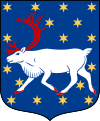Västerbotten
Västerbotten | |
|---|---|
 | |
| Country | |
| Land | Norrland |
| County | Västerbotten County |
| Area | |
• Total | 15,093 km2 (5,827 sq mi) |
| Population (2016)[1] | |
• Total | 220,175 |
| • Density | 15/km2 (38/sq mi) |
| Ethnicity | |
| • Language | Westrobothnian |
| Culture | |
| • Flower | Moor-king lousewort |
| • Animal | Curlew |
| • Bird | Hen harrier |
| • Fish | Lamprey |
| Time zone | UTC+1 (CET) |
| • Summer (DST) | UTC+2 (CEST) |
Västerbotten (Swedish: [ˈvɛ̂sːtɛrˌbɔtːɛn] ⓘ), known in English as West Bothnia or Westrobothnia, is a province (landskap) in the north of Sweden, bordering Ångermanland, Lapland, North Bothnia, and the Gulf of Bothnia. It is known for the cheese named after the province.[citation needed]
Administration
The traditional provinces of Sweden serve no administrative or political purposes, but are historical and cultural entities. The administrative county, Västerbotten County, consists of the province and the southern part of Swedish Lappland.[citation needed]
Heraldry
On 18 January 1884, all provinces gained the rights to the rank of duchy, and the arms can be represented with a ducal coronet. Blazon: "Azure Seme of Mullets Or a Reindeer in full course and hoofed Gules."[citation needed]
Geography
Västerbotten was historically divided into chartered cities and districts.[citation needed]
Cities
- Umeå (1622)
- Skellefteå (1845)[citation needed]
Communes/Municipality
Facts
- Highest mountain: Åmliden (550 meters)
- Largest lake: Bygdeträsket[citation needed]
History

Up until the Finnish War 1808–1809, and the Treaty of Fredrikshamn, the province of Västerbotten also included a small portion of the extreme north of current Finland. This part has later been integrated in Lapland, Finland. The Österbotten, Eastern Botten or Ostrobothnia, lay on the Finnish side of the sea, and this province name still survives.
Following the Fredrikshamn treaty, which re-defined the outlines and orientation of Sweden, in 1810, Västerbotten County was split in two parts. The northern portion became Norrbotten County, and the Swedish-speaking locals of Norrbotten (which in itself is a multi-lingual area) soon began referring to themselves as Norrbothnians. The county borders thus gradually led to a local provincial identity. Nowadays Norrbotten is considered a separate province, even though provinces had ceased to have any administrative or legal significance hundreds of years before 1810.
Västerbotten Regiment was the provincial regiment.[citation needed]
Dukes of Västerbotten
Since the 13th century, Swedish princes in some dynasties have been created dukes of various provinces. Since 1772, these are only nominal titles.
- Prince Gustaf Adolf (1906-1947)
Geography
Lakes and watercourses
|
Lakes |
Watercourses |
Watercourses |
Sports
Regional football in the province is administered by Västerbottens Fotbollförbund. Ice hockey is also popular, with IF Björklöven and Skellefteå AIK.[citation needed]
References
- ^ "Folkmängd i landskapen den 31 december 2016" (in Swedish). Statistics Sweden. 21 March 2017. Retrieved 2017-11-27.
- ^ https://www.1177.se/Vasterbotten/sa-fungerar-varden/varden-i-vasterbotten/kontakt/kommuner-i-vasterbottens-lan/


